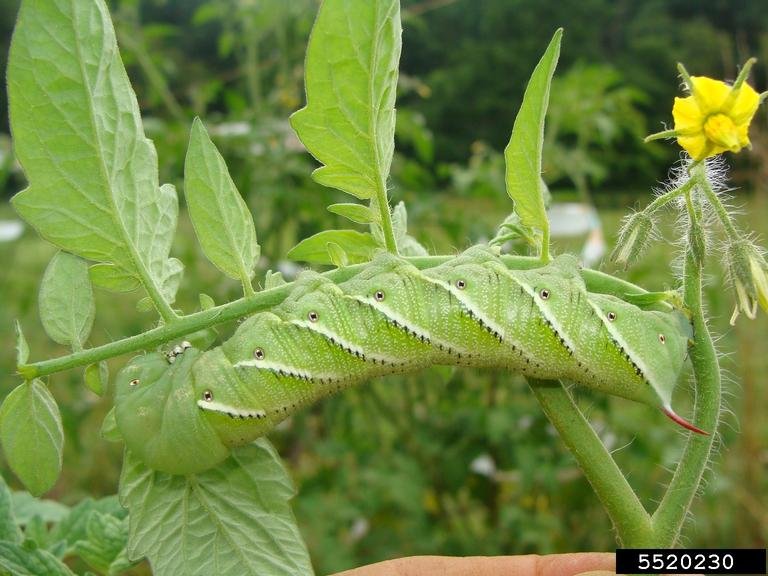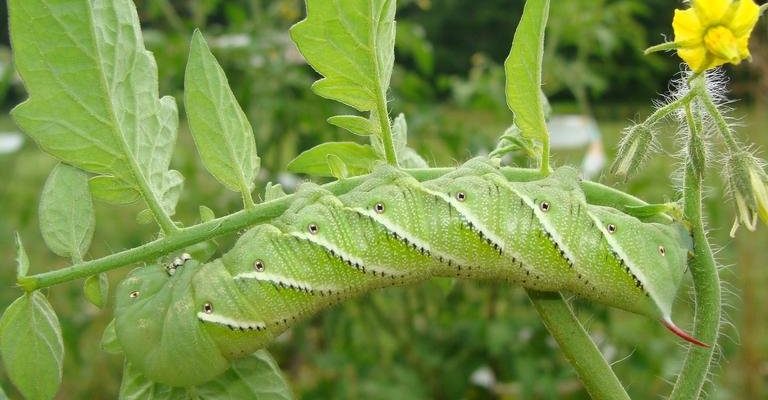
Hornworms are the larval stage of hawk moths, and they can wreak havoc on your plants, particularly tomatoes and peppers. As they munch away, their feeding can lead to a variety of symptoms, including leaf curling. Understanding this relationship is crucial for any gardener looking to maintain a healthy and vibrant garden. So, let’s explore this topic further, digging into the details surrounding hornworms and leaf curling.
What Are Hornworms?
Hornworms are the larvae of the five-spotted hawk moth and are known for their striking green color and horn-like protrusions on their rear ends. They can grow up to 4 inches long and can devour a surprising amount of leaves in a short time. It’s almost like they have a bottomless appetite!
When you spot these caterpillars in your garden, it’s often a sign that your plants are in trouble. Hornworms don’t just nibble; they can strip entire plants bare. For a gardener, the sight can be alarming. Picture this: one day, your tomato plant is lush and green, and the next, it looks like it’s gone through a rough night.
Honestly, if you’re growing tomatoes, peppers, or eggplants, keep an eye out for hornworms. They blend in with the foliage, making them easy to miss. Look for dark droppings or frass on the leaves—an unmistakable sign you have guests that overstay their welcome.
How Do Hornworms Impact Leaf Curling?
You might be wondering what exactly happens to the leaves when hornworms feast. As they chew through various parts of the plant, they can lead to several physiological changes. Leaf curl is one of those changes, but it isn’t always directly due to hornworm feeding.
The stress from hornworms feeding can cause a hormone imbalance in the plant. Imagine a person trying to relax while someone keeps poking them—it’s tough to stay calm! This stress can lead to the plant curling its leaves as a protective mechanism. Essentially, the plant is trying to conserve water and reduce its surface area exposed to the elements.
For more severe infestations, the physical damage from the hornworms can also lead to leaf curling. The leaves lose their ability to produce energy effectively through photosynthesis, leaving them feeling limp and deformed. It’s a chain reaction that can spell disaster for your plants.
Other Causes of Leaf Curling
While hornworms can indeed contribute to leaf curling, they aren’t the only ones in the garden that can cause this issue. Here are some common culprits:
- Environmental Stress: Too much heat or fluctuating temperatures can make leaves curl. It’s like getting too hot at a picnic—the discomfort makes you want to retreat!
- Pests: Other pests, such as aphids or spider mites, can suck the juices out of leaves, causing them to curl. Think of these pests as tiny vampires, draining life from your plants.
- Nutrient Deficiencies: A lack of essential nutrients, especially nitrogen, can lead to poor plant health and curling leaves. If plants are starved, they’ll definitely show signs of distress.
This means that if you see curled leaves, a thorough investigation is necessary. Don’t just assume it’s the hornworms. Look around; there may be multiple factors at play.
Identifying Hornworms in Your Garden
If you suspect hornworms are the cause of your leaf curling, identifying them is key. Here are some tips to help you pinpoint these sneaky pests:
1. Look for Damage: Check your plants for signs of nibbling. If the leaves look like they’ve been hastily chewed, that’s a clue.
2. Check the Undersides: Hornworms often hide on the undersides of leaves. This is their stealth mode, avoiding detection while they munch away.
3. Examine Their Color: These caterpillars can blend in, but if you look closely, their characteristic green color can be spotted against the leaves.
4. Identifying Frass: If you find small black droppings (frass) on leaves or around the base of the plant, that’s a good indication you have hornworms.
By spotting them early, you can take action before they do too much damage. It’s like catching a thief before they get away with your prized tomatoes!
How to Control Hornworms
Once you’ve identified hornworms as the culprits, you want to take action quickly. Here are a few methods to control their population:
- Hand-Picking: If you see hornworms, pick them off by hand. It’s the most direct method and provides immediate relief to your plants.
- Natural Predators: Encourage birds and beneficial insects into your garden. These natural predators enjoy munching on hornworms and can help keep their numbers down.
- Pesticides: If your infestation is severe, consider using organic pesticides like Bacillus thuringiensis (Bt). It’s targeted specifically at caterpillars and won’t harm beneficial insects.
Keeping your garden healthy through regular monitoring can also help prevent hornworms from taking over. Think of it as a regular check-up for your plants!
Preventing Hornworm Infestations
Prevention is always better than cure, right? To keep hornworms at bay, here are some top tips:
- Crop Rotation: Rotate your crops each year to disrupt the life cycle of hornworms.
- Healthy Soil: Ensure your plants are healthy by enriching your soil with organic matter. Healthy plants are better equipped to withstand pests.
- Regular Inspections: Make it a habit to check your plants regularly. Addressing issues early can save you a lot of hassle later.
By taking these preventive steps, you can ensure your garden remains a thriving ecosystem rather than a buffet for hornworms.
So, is there a link between hornworms and leaf curling? Absolutely! Hornworms can cause stress and physical damage to your plants, leading to leaf curling. However, they aren’t the sole offenders. By keeping an eye on your garden and understanding the signs, you can mitigate the impact of these pests.
At the end of the day, maintaining a healthy garden requires vigilance and care. With the right knowledge and tools, you can enjoy a flourishing garden without the unwelcome guests. Happy gardening!

